On the evening of Nov. 17, a hallway in Fayerweather was crowded with visitors examining pairs of artworks that looked unmistakably similar… but not exactly the same. One of each pair was a print of a work from the Mead Art Museum’s collection. The other was an attempt to replicate that work using an OpenAI computer program called DALL-E. What we were perusing was billed as “Amherst College’s first exhibition of art generated through artificial intelligence.”
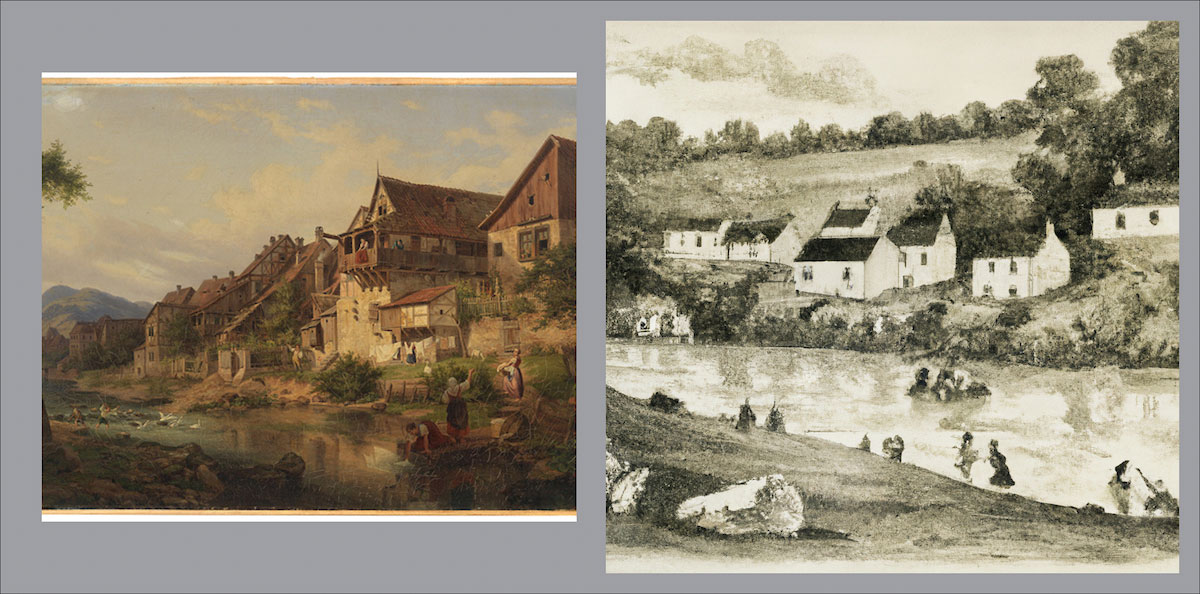
Left: Johann Gottfried Pulian, German (1809–1875). View of the Environs of Dresden. Painting, oil on canvas.
Right: Artwork generated by DALL-E.
Prompt: “A row of cottages along the bank of a river with people standing on verandas, clothes hanging on lines; at lower right women doing their washing in the stream; at the left, boys chasing geese in the water. In the middle ground at left, a small hill.”
Through exposure to an enormous set of examples from the internet, DALL-E has been trained to create visual representations when prompted with textual descriptions. For this exhibition, Reihaneh Iranmanesh ’25 later explained, the prompts for each artwork were descriptive captions taken directly from the Five Colleges Collections Database. (Keywords and images in the Mead’s collection were the focus of Iranmanesh’s Summer Undergraduate Research Fellowship project.)
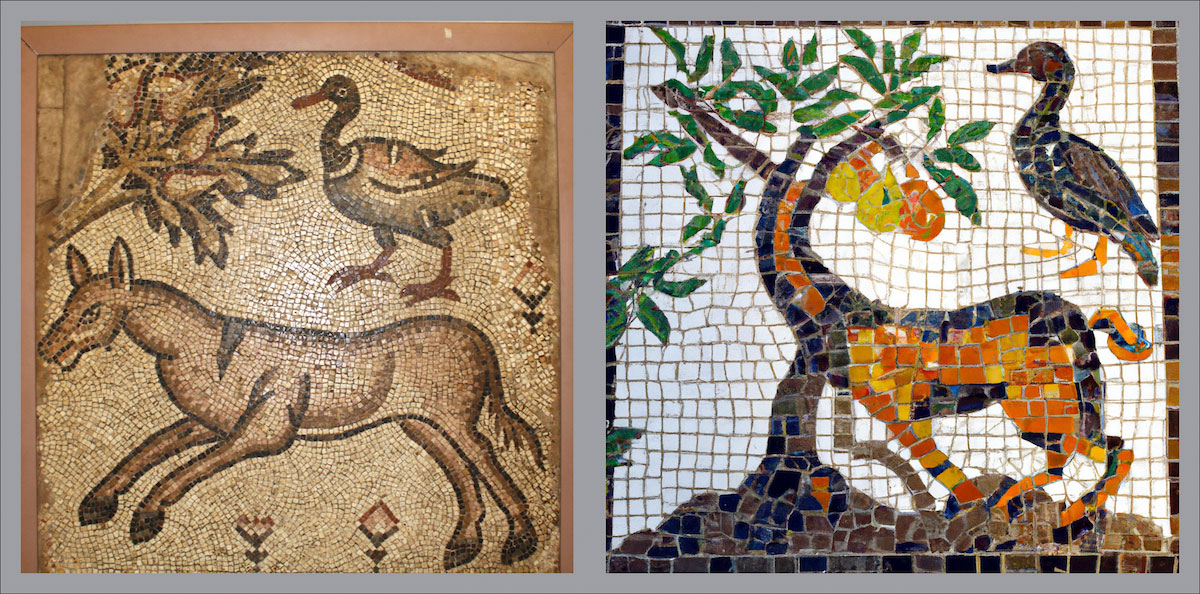
Left: Unknown, Early Christian. Mosaic Panel from a Church. 5th–6th century CE. Mosaic, marble tesserae.
Right: Artwork generated by DALL-E.
Prompt: “The mosaic panel depicts a doe, duck, and a pear tree. The doe executed in black and ochre, brown and beige, the duck in shades of red-brown black and ochre; the pear tree in green-gray, brown and orange and black.”
“There were only two instances where the prompt was altered very slightly,” noted Wendy Espinosa ’25, who helped to organize the exhibition. An illustrated panel from an early Christian church (above) had to be specifically identified as a “mosaic,” and for Guidoccio Cozzarelli’s Virgin and Child with Angels (below), the name “Mary” had to be added to the prompt; otherwise the AI program would flag the depiction of “The Virgin, wearing a red dress …” as inappropriate. “If you wish to use DALL-E to recreate these paintings effectively, those two words are quite crucial!” Espinosa said.
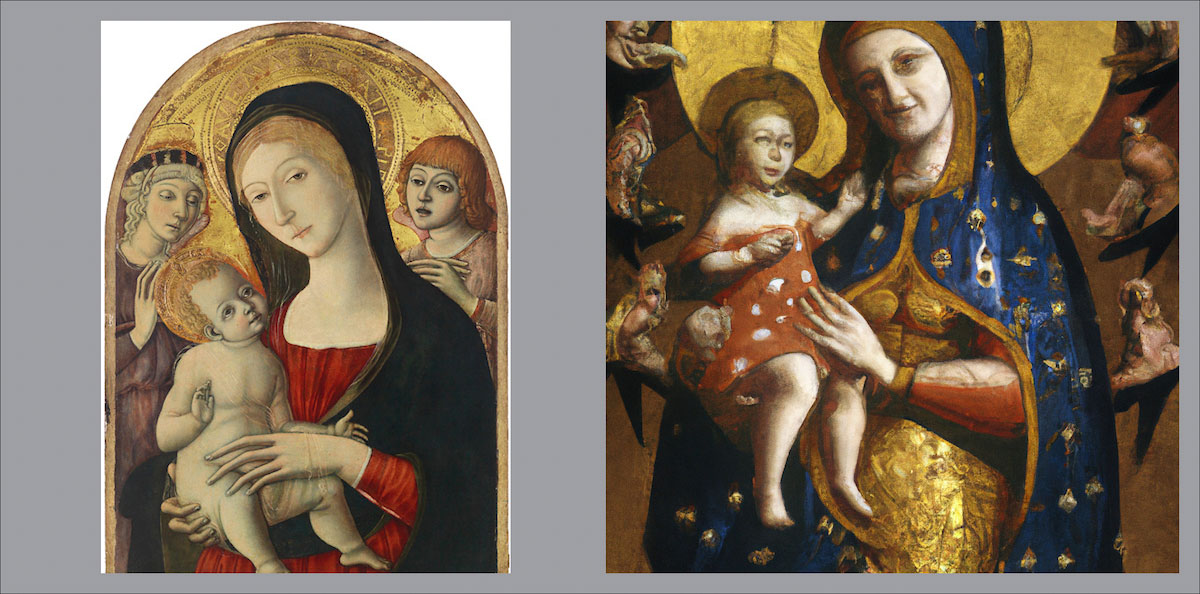
Left: Guidoccio Cozzarelli, Italian (1450–1516). Virgin and Child with Angels. ca. 1485. Painting, tempera on panel.
Right: Artwork generated by DALL-E.
Prompt: “The Virgin Mary, wearing a red dress and a dark blue robe with green lining, stands before a gold leaf background. She is turned three-quarters to the left and holds the Child on her right arm. Her halo bears the description: Ave Maria Gratia Plena (Hail Mary, full of grace), from Luke I.28. Behind Mary are two adoring angels.”
Both she and Iranmanesh are participants in the Artificial Intelligence in the Liberal Arts initiative, led at Amherst by Lee Spector, the Class of 1993 Professor of Computer Science. That evening in Fayerweather, Spector moderated a panel discussion titled “Discussing DALL-E: The Impact of AI on Art,” featuring three assistant professors of computer science: Scott Alfeld, who studies the security concerns surrounding AI; Lillian Pentecost, who focuses on the future of computer memory systems; and Will Rosenbaum, who researches abstract computational models of distributed systems. The computer scientists talked to the audience in Pruyne Lecture Hall—some two dozen students, staff, faculty and members of the public—about how DALL-E works and its broader technological context.

Left: Romare Bearden, American (1911 or 1912–1988). In The Garden. 1979. Print, color lithograph.
Right: Artwork generated by DALL-E.
Prompt: “A dark-skinned woman in a pink checkered dress stands at the center, a straw hat covering her bobbed hair, green bangles on her wrist. Her right hand is raised into a wave while her left hand is holding up a basket of bright red fruit to her waist. Behind the woman, we see greenery in the background, as well as a grey building with a red chimney in the distance and, closer to the woman, a red structure.”
Spector asked, “What do you see as the prospects for AI to become an ‘artist’?” The panelists agreed that AI programs will be able to follow instructions to produce larger quantities of imagery faster than human artists can, and for less money. “But can they assess the significance of it?” Spector wondered.
“I’m not sure I know what a ‘traditional artist’ is,” said Yael Rice, associate professor of art and the history of art and of Asian languages and civilizations, also on the panel. She pointed out that artists through the ages have relied on advances in technology, and on the labor of assistants and apprentices who follow their instructions. Similar questions to those we’re now asking about AI have historically been asked about, for example, photography: Does using a camera, “a tool that seems to reproduce what we see with human vision,” count as creating art?
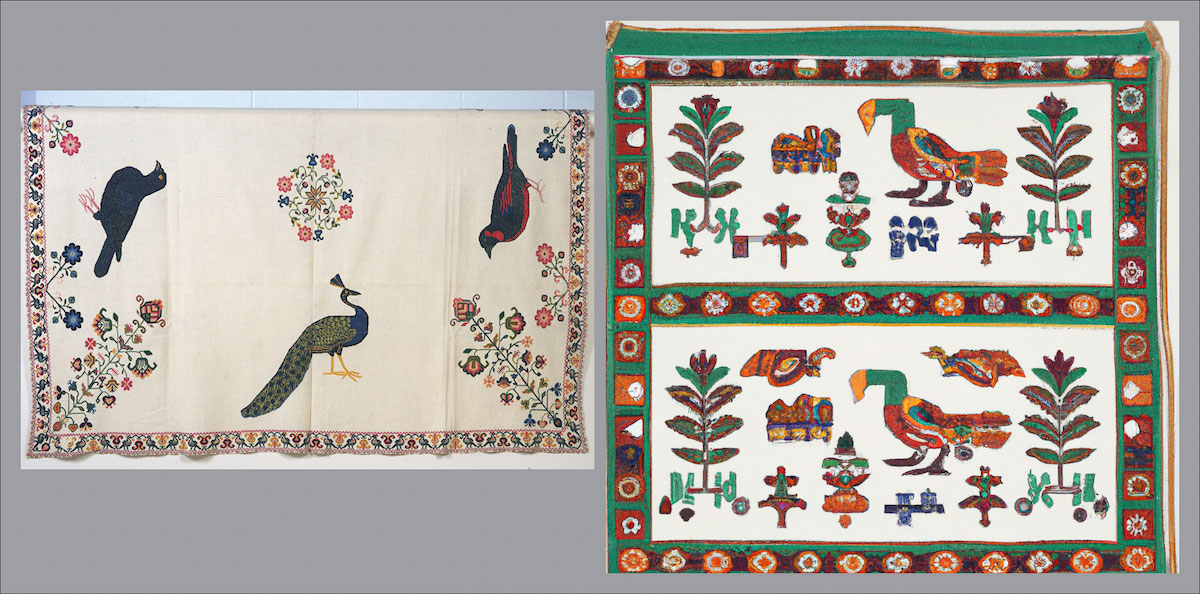
Left: Unknown, Mexican. Bed Cover (Sobrecama). Early 20th century. Bedding, embroidered wool.
Right: Artwork generated by DALL-E.
Prompt: “Chain-stitched, embroidered decorative designs: border of quail and lyre-like designs closed by narrow undulating ribbons; floral spays matching in opposite corners; in center, diamond-shaped floral pattern. In the field on each side a large bird including eagle, crow, peacock, and unknown unidentified species.”
Comments from the audience raised even more questions for consideration. How does the use of AI compare to older practices of collage or sampling, directing films or conducting an orchestra? Could we someday create an AI art critic? What about issues of profit motive, copyright, forgery and deepfakes (manipulated footage that falsely depicts what people have done or said)?
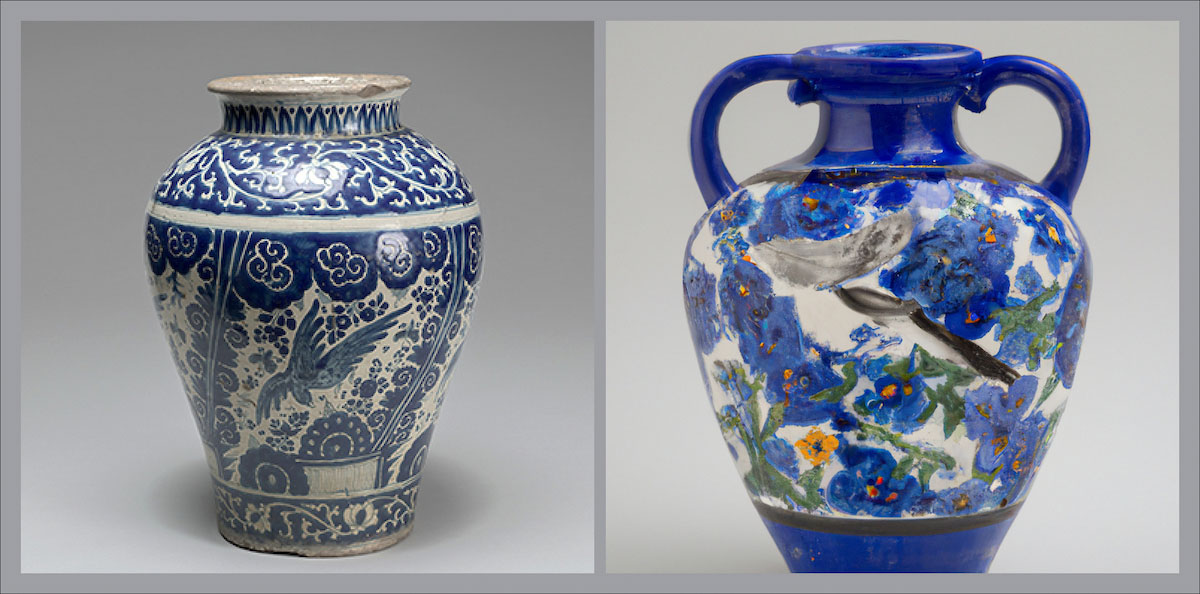
Left: Unknown, Mexican. Jar (Jarrón). Late 18th century. Ceramic, glazed earthenware.
Right: Artwork generated by DALL-E.
Prompt: “Blue and white Talavera style jar with irregular reserves, with flying bird motif in light blue in the center with deeper blue flowers in field and floral design above, each panel separated by diagonal floral and scroll design; on a white ground. Band below shoulder with blossom and branch design. Hatched band on neck, flaring lip, tin container inside.”
Toward the end of the discussion, Rice reminded everyone of the “specter of bias.” Human beings have prejudices and gaps in our understanding (regarding race, gender, language and so much more), so any algorithms we design are likely to reflect and reproduce those biases. For better and worse, the machines are learning from us.

Left: Yashima Gakutei, Japanese (ca. 1786–1868). The Dancing Girl Bimyō (Maijo Bimyō), Mirror of the
East (Azuma Kagami), from the series Twenty-Four Japanese Examples of Filial Piety for the Honchōren (Honchōren Honchō Nijūshikō). ca. 1821–22. Print, woodblock print (surimono); ink and color on paper with metallic and embossed embellishments.
Right: Artwork generated by DALL-E.
Prompt: “A young woman dancing in front of a folding screen, performing as a shirabyōshi, a female dancer dressed in male court costume, an open fan in her hand and a sword in her belt; patterns of paulownia leaves and flowers on her kimono, and waves on her hakama (pants). A poem by Haginoya Torikane on the right.”
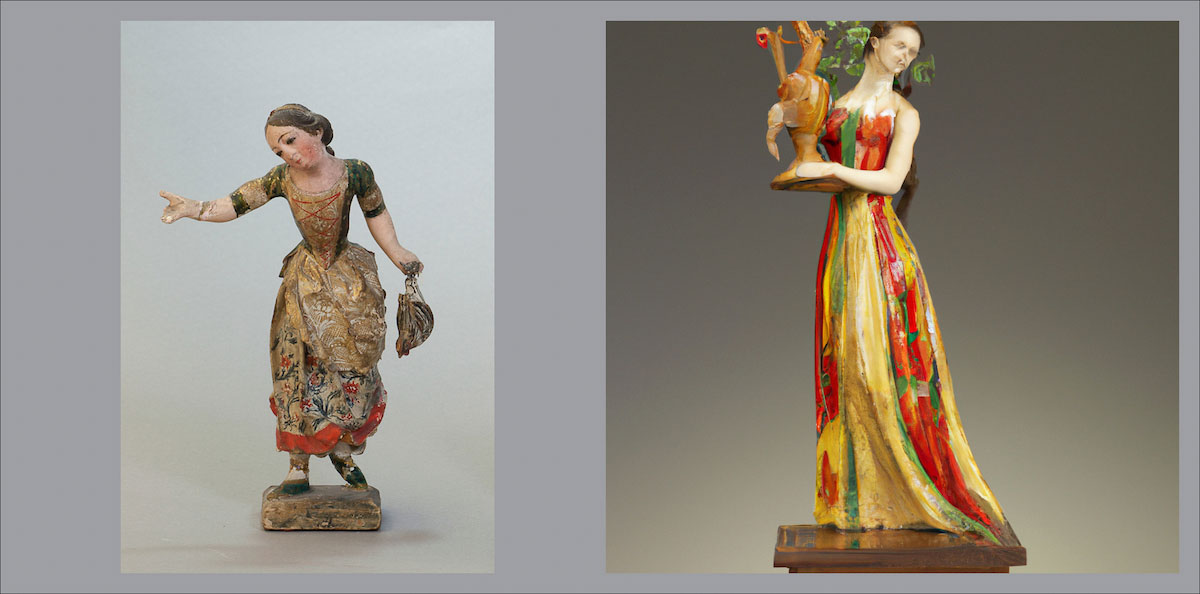
Left: Unknown, Mexican. Figurine of a Woman with Chicken (Mujer con Pollo). Late 18th century. Sculpture, painted wood and cloth.
Right: Artwork generated by DALL-E.
Prompt: “Figure of a young woman, standing with head tilted to one side, one arm outstretched, the other by her side holding a chicken. Long dark hair, with gold ribbon in back. Tight-bodiced gown with green bodice, red and gold skirt with sprigs of flowers; gold apron. Small wooden base.”